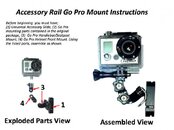Hi everyone,
The name is Jay. I've had my basic and nitrox certs from NAUI for a little over a year now. I didn't really have any idea of where I wanted to go with scuba after my certification (just that I love the water and wanted to give it a try) but my job granted me the opportunity to go to Kona Hawaii on a business trip where I took advantage of the free flight and acquired the 4 dives that I currently have under my belt (morning, afternoon, dusk, and night dive with manta rays all in one day!). This summer me and my dive buddy from my scuba class are planning on exploring all the sites that Panama City, FL has to offer (we live in Louisiana so it's an easy drive). Anyways, I'm very interested in using a full face mask because of two key features: 1. no fogging and 2. no biting down on the regulator. I'm almost 100% certain that I want to go with an OTS Guardian FFM and I've mentioned getting certified in FFM via NAUI to the instructors at my local dive shop but they just said that I "don't need one yet" and that it would be a smarter choice to get my advanced cert first and then do the FFM one. I feel that I can trust them but at the same time I can't help but feel that they're just trying to get more courses out of me (they ARE a business after all) so my question to you all is what route would you take? What are the pros and cons to each route? Thanks in advance for your advice.
The name is Jay. I've had my basic and nitrox certs from NAUI for a little over a year now. I didn't really have any idea of where I wanted to go with scuba after my certification (just that I love the water and wanted to give it a try) but my job granted me the opportunity to go to Kona Hawaii on a business trip where I took advantage of the free flight and acquired the 4 dives that I currently have under my belt (morning, afternoon, dusk, and night dive with manta rays all in one day!). This summer me and my dive buddy from my scuba class are planning on exploring all the sites that Panama City, FL has to offer (we live in Louisiana so it's an easy drive). Anyways, I'm very interested in using a full face mask because of two key features: 1. no fogging and 2. no biting down on the regulator. I'm almost 100% certain that I want to go with an OTS Guardian FFM and I've mentioned getting certified in FFM via NAUI to the instructors at my local dive shop but they just said that I "don't need one yet" and that it would be a smarter choice to get my advanced cert first and then do the FFM one. I feel that I can trust them but at the same time I can't help but feel that they're just trying to get more courses out of me (they ARE a business after all) so my question to you all is what route would you take? What are the pros and cons to each route? Thanks in advance for your advice.




